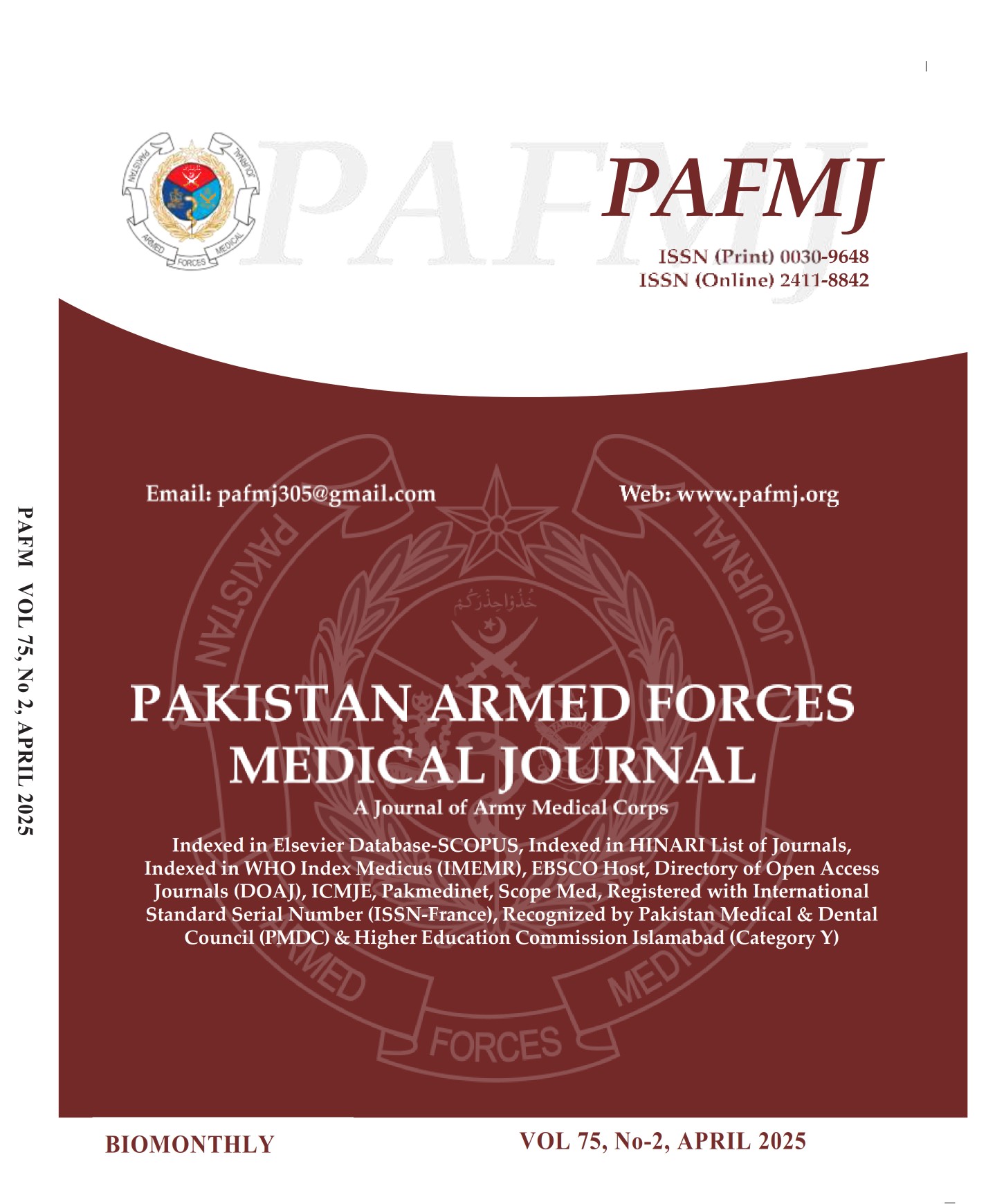Role of Autologous Platelet Rich Plasma in Timely Healing of Chronic Diabetic Foot Ulcer
DOI:
https://doi.org/10.51253/pafmj.v75i2.11669Keywords:
Diabetic foot ulcers, Platelet-rich plasma, Wound healingAbstract
Objective: To evaluate the efficacy of platelet-rich plasma in treating chronic non-healing diabetic foot ulcers, in comparison to conventional dressings.
Study Design: Quasi-experimental study.
Place and Duration of Study: General Surgery Department of Combined Military Hospital Rawalpindi, Pakistan from Jun- Dec 2023.
Methodology: A comparative study was conducted on patients with persistent non-healing diabetic foot ulcers. The study participants were split up into two groups. In Group-A, platelet-rich plasma was injected into the ulcer's base and the wound's borders. In Group-B, the ulcer was treated with saline-soaked moist dressings. Every patient underwent two months of follow-up, with planned follow-up visits on 7th, 14th, 30th, 45th, and 60th days. Autologous PRP's effectiveness in treating chronic diabetic foot ulcers was compared with conventional dressings.
Results: Mean age of 120 patients was 55.98±9.71 years. 108(90%) were males and 12(10%) were females. At the end of two months, 53(88.8%) patients from Group-A showed a significant reduction in wound grade as compared to 28(46%) patients from Group-B (p=<0.001). Furthermore, 48(80%) patients from Group-A experienced complete wound healing after 02 months as compared to 14(23.3%%) patients from Group-B (p=<0.001)
Conclusion: Treating chronic non-healing diabetic foot ulcers with Autologous Platelet-Rich Plasma is associated with better and expedited wound healing.
Downloads
References
Banday MZ, Sameer AS, Nissar S. Pathophysiology of diabetes: An overview.Avicenna J Med 2020; 10(4): 174-188.
https://doi.org/10.4103/ajm.ajm_53_20
Deshpande AD, Harris-Hayes M, Schootman M. Epidemiology of diabetes and diabetes-related complications.Phys Ther 2008; 88(11): 1254-1264. https://doi.org/10.2522/ptj.20080020
Bommer C, Sagalova V, Heesemann E, Manne Goehlar J, Atun R, Barnighausen T et al. Global Economic Burden of Diabetes in Adults: Projections From 2015 to 2030.Diabetes Care 2018; 41(5): 963-970. https://doi.org/10.2337/dc17-1962
Sun H, Saeedi P, Karuranga S, Pinkepan M, Ogurtsova K, Duncan BB et al. IDF Diabetes Atlas: Global, regional and country-level diabetes prevalence estimates for 2021 and projections for 2045 [published correction appears in Diabetes Res Clin Pract 2023; 204: 110945].Diabetes Res Clin Pract https://doi.org/10.1016/j.diabres.2021.109119
McDermott K, Fang M, Boulton AJM, Selvin E, Hicks CW. Etiology, Epidemiology, and Disparities in the Burden of Diabetic Foot Ulcers.Diabetes Care 2023; 46(1): 209-221.
https://doi.org/10.2337/dci22-0043
Kim J. The pathophysiology of diabetic foot: a narrative review.J Yeungnam Med Sci 2023; 40(4): 328-334.
https://doi.org/10.12701/jyms.2023.00731
Tang W, Zhao Y, Cheng Z, Xu J, Zhang Y, Liu X. Risk factors for diabetic foot ulcers: A systematic review and meta-analysis.Vascular 2023; 32(3): 661-669.
https://doi:10.1177/17085381231154805
Wang X, Yuan CX, Xu B, Yu Z. Diabetic foot ulcers: Classification, risk factors and management.World J Diabetes 2022; 13(12): 1049-1065.
https://doi.org/10.4239/wjd.v13.i12.1049
Shah P, Inturi R, Anne D, Jadhav D, Viswabharan V, Khadilkar R et al. Wagner's Classification as a Tool for Treating Diabetic Foot Ulcers: Our Observations at a Suburban Teaching Hospital.Cureus 2022; 14(1): e21501.
https://doi.org/10.7759/cureus.21501
Pixley JN, Cook MK, Singh R, Larrondo J, McMichael AJ. A comprehensive review of platelet-rich plasma for the treatment of dermatologic disorders.J Dermatolog Treat 2023; 34(1): 2142035. https://doi.org/10.1080/09546634.2022.2142035
Ullah A, Jawaid SI, Qureshi PNAA, et al. Effectiveness of Injected Platelet-Rich Plasma in the Treatment of Diabetic Foot Ulcer Disease.Cureus 2022; 14(8): e28292.
https://doi.org/10.7759/cureus.28292
Sapra A, Bhandari P. Diabetes. [Updated 2023 Jun 21]. In: StatPearls [Internet]. Treasure Island (FL): StatPearls Publishing; 2023 Jan-.
Akhtar S, Ali A, Ahmad S, Khan MI, Shah S, Hassan F. The prevalence of foot ulcers in diabetic patients in Pakistan: A systematic review and meta-analysis.Front Public Health 2022; 10: 1017201. https://doi.org/10.3389/fpubh.2022.1017201
Kavitha KV, Tiwari S, Purandare VB, Khedkar S, Bhosale SS, Unnikrishnan AG. Choice of wound care in diabetic foot ulcer: A practical approach.World J Diabetes 2014; 5(4): 546-556. https://doi.org/10.4239/wjd.v5.i4.546
Baria M, Vasileff WK, Miller M, Borchers J, Flanigan DC, Durgam SS. Cellular Components and Growth Factor Content of Platelet-Rich Plasma With a Customizable Commercial System.Am J Sports Med. 2019; 47(5): 1216-1222.
https://doi.org/10.1177/0363546519827947
Raza A, Ismail M, Salma U, Haq N, Khan M, Shuja M. (2023). Role of Autologous Platelet Rich Plasma in Management of Chronic Wounds.J Population Therapeutics Clin Pharmacol 30(14), 230–234. https://doi.org/10.47750/jptcp.2023.30.14.030
Ahmed M, Reffat SA, Hassan A, Eskander F. Platelet-Rich Plasma for the Treatment of Clean Diabetic Foot Ulcers.Ann Vasc Surg 2017; 38: 206-211.
https://doi.org/10.1016/j.avsg.2016.04.023
Kunder V, Sharma KC, Rizvi Z, Soubelet R, Ducharme M. The Use of Platelet-Rich Plasma in the Treatment of Diabetic Foot Ulcers: A Scoping Review.Cureus 2023; 15(8): e43452.
https://doi.org/10.7759/cureus.43452
Singh SP, Kumar V, Pandey A, Pandey P, Gupta V, Verma R. Role of platelet-rich plasma in healing diabetic foot ulcers: a prospective study.J Wound Care 2018; 27(9): 550-556.
https://doi.org/10.12968/jowc.2018.27.9.550
Hu Z, Qu S, Zhang J, Cao X, Wang P, Huang S et al. Efficacy and Safety of Platelet-Rich Plasma for Patients with Diabetic Ulcers: A Systematic Review and Meta-analysis.Adv Wound Care 2019; 8(7): 298-308.
Downloads
Published
Issue
Section
License
Copyright (c) 2025 Muhammad Faaiz Ul Marram, Waseem Ahmad Khan, Muhammad Imran, Waleed Umer, Zahoor Muhi Ud Deen, Fahad Nazir Malik

This work is licensed under a Creative Commons Attribution-NonCommercial 4.0 International License.















